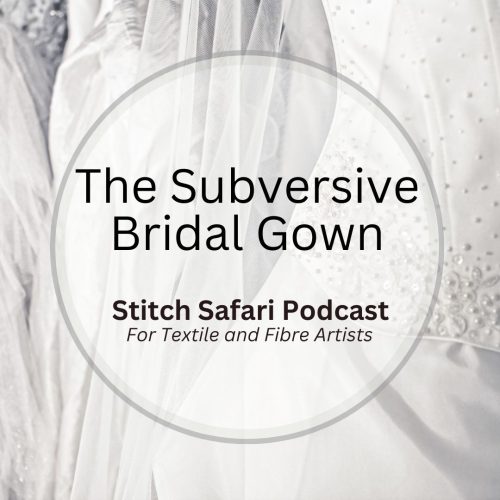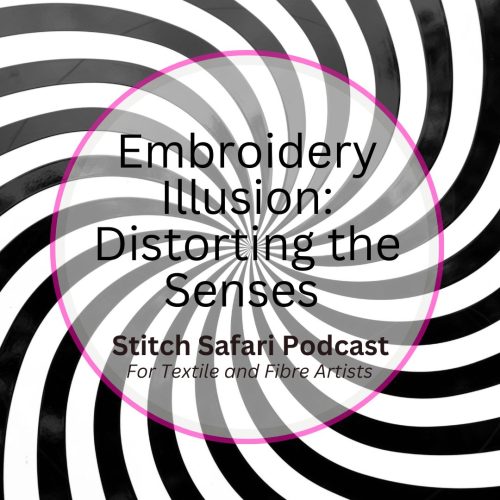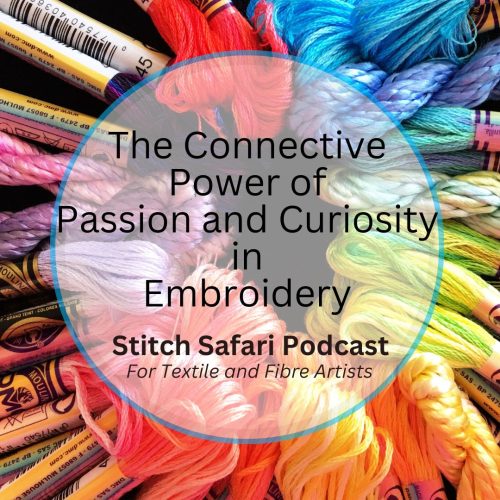Constance Howard, the British embroiderer, often best remembered for her green hair, had a colossal influence on contemporary embroidery at a time when it was deemed to be a comparatively minor craft, setting a pathway that’s probably helped lead to the expansion of the textile arts as we know them today.
The important role textiles and embroidery hold today, is due a great deal, to her work and example.
Describes by the Guardian as a remarkable artist, an inspiring teacher, and an extraordinary character, Constance Howard was arguably the most influential British pioneer in textile design of her generation.
The Telegraph wrote that ‘Howard helped raise embroidery from the status of genteel hobby to that of an art form’.
Born in 1910, Constance was denied a grant to the Royal College of Art because it was believed the money would be wasted on a woman who would eventually marry.
Teaching at the Kingston-upon-Thames School of Art where she met fellow tutor, Harold Parker, whom she did marry in 1945.
Constance related this memory of that time: ‘I was in charge of the dress and millinery department at the Kingston-upon-Thames School of Art during the war years. The School remained open for full-time and part-time students. With the shortage of materials and rationing of most commodities, ingenuity was shown by both the staff and the students in conserving what stocks of materials we had and using them with care. We could not cut into our few good pieces of cloth, so students took turns to drape fabrics on stands to explore ideas, after which they developed their designs on paper, adding imaginative features such as patterns of embroidery to their drawings. Salvaged materials were bought at very low prices, pure silk taffeta was as little as 1 and 6 per yard, and linen 1 shilling per yard. Make-do-and-mend classes flourished, and old garments were refurbished and decorated with embroidery.’
Constance also recounts embroidered maps made by students and staff at Kingston for the RAF as part of the school’s war work: ‘This we did during the vacations, working on a very tough, water-rough fabric that gave us sore hands from the effort of pushing the needles through the close weave. We worked wooded areas in French knots, placed solidly together, in tapestry wools and others of a similar weight in several shades of green on an olive green background. Stitches were worked over one another to give a slightly raised effect to some of the hills, stem stitch separating the fields and roads. These maps were, apparently, more accurate than photographs in depicting relief because of the raised stitches.’
Two years after her marriage, Constance became a part-time tutor at Goldsmiths College in south-east London, founded in 1891 specializing in the arts, design, humanities, and social sciences.
Constance went on to establish an embroidery department at a time when London was struggling to find its feet again after the devastation of WWII.
She became the principal lecturer in charge of textiles and fashion, promoting and nurturing the concept that embroidery was an art form and the perfect vehicle for artistic self-expression, while also building the tradition that helped give Goldsmiths College its leading role in art and design.
As founder of the Embroidery Department at Goldsmiths, Constance was able to employ such innovative teachers as Christine Risley, Barbara Dawson, Maurice, and Jane De Saumariz, David Green, Professor Ann Morrell, Eirian and Denys Short, and Harry and Elma Thruberon, helping to develop a courageous and innovative path for students of embroidery.
Even after her retirement in 1975, her standing continued to grow, partly due to her visiting lectures in Europe and the US, along with the authorship of a number of key texts.
In 1980 Audrey Walker established the Constance Howard Textiles Special Collection, containing more than 2,000 textile pieces and related items – many of major historical importance, documenting the pioneering history of textiles at Goldsmiths through the use of slides, from its initial beginnings in the late 1940s to the present day.
In 2002 The Constance Howard Resource and Research Centre in Textiles was founded containing numerous textiles she donated on the basis they would be stored in perpetuity, along with her invaluable teaching notes and experimental samples created by her students at Goldsmiths from 1952-1975, forming a landmark history of British twentieth-century textile art, telling a unique and distinctive story of creativity and innovation.
One of Constance Howard’s Design Teaching Aids formed part of her bequest – it’s a set of black mounted images that include embroidery, magazine cuttings, drawings, design motifs, and solutions.
This small, slight yet energetic woman had the ability to attract and recruit newcomers to her way of thinking and in 1975 was awarded the MBE for services to embroidery.
She remained powerfully individualistic retaining her enthusiasm for textiles which she was able to communicate to everyone, but she was no shrinking violet – dyeing her hair from the 1930s, allegedly using lithographers’ green ink as hair dye, later switching to fluorescent green.
A Goldsmith’s lecture held in her honour, saw this indomitable woman, at this time in her 90s, stand out from the rest of the audience, with students remembering her as kind and patient, endearing her to generations of students.
She was also a prolific author, penning Design for Embroidery From Traditional English Sources in 1956, Inspiration for Embroidery in 1966, Embroidery & Colour in 1976, Textile Crafts in 1977 and in 1979 came The Constance Howard Book of Stitches.
Over the next few years, Constance researched and wrote the classic four-volume study, Twentieth Century Embroidery in Great Britain.
The importance of the work and impact of Constance Howard goes far beyond Goldsmiths – she was considered the most influential British pioneer in the field of textile design of her generation.
Constance Howard’s legacy is that of innovation in the textile arts – constructing that ever-important dialogue between drawing and stitch.
Professionally, the impact she had on contemporary embroidery was enormous, but it was also that sense of developing a belief in the scope and possibilities of textile work during the second half of the twentieth century, where she was most effective.
Remembered as an innovator and revolutionary, many important artistic genres owe a huge amount to the work and example of Constance Howard, helping to nurture the idea of embroidery as an art form and vehicle for artistic self-expression.
Significantly, during the 1950s and ’60s, embroidery and textile art was contained within the confines of the flat dimension, similar to fine art, and while Constance Howard may not have changed this attitude, she did work to expand the possibilities that existed between those boundaries.
By the late 1960s, there was a feeling that embroidery wanted to escape from the confines of illustration to be explored on a far more adventurous level – and so it has.
Students were strongly grounded in basic embroidery and drawing techniques and allowed to develop their own style entirely, often travelling down paths they would not have otherwise taken.
Constance Howard formed part of the vanguard of the renaissance of modern embroidery, influencing generations of embroiderers and textile artists.
This quiet revolution saw embroidery move from an occasional sedative occupation to one of refined and justifiable art.
So looking at embroidery from the contexts of drawing, design, technique and innovation, Constance Howard was certainly a trailblazer, garnering a worldwide influence.
I think it’s so easy to forget those who have gone before us, but in my opinion, it’s essential to understand not only how the world of embroidery has grown but also its roots or genesis – where it’s actually come from and how it’s moved forward.
Add to that, the importance Constance Howard put on observing and drawing to create original embroidery designs is a significant step in that genesis.
I’m going to leave you with this from Constance Howard, written in her Introduction to her book ‘Inspiration for Embroidery’, published in 1966, by BT Batsford: ‘The popularity of embroidery has increased during recent years, and with this, a higher standard of design and workmanship has developed, but there is still much scope for the encouragement of originality in ideas and the ways and means by which design and pattern making may be understood more fully.
Technical skill is only a part of any craft, with which progress is limited, but ‘how to make something’, without building up aesthetic appreciation and a sensibility in taste, is worthless.’
And I think that says it all.





